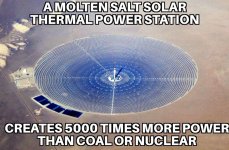Been reading about South Australias thermal solar molten salt power-station.
There has only been one other molten salt power-station that has been done in the "tower" configuration, a few more in the parabolic configuration which seems to be far more popular with the water/steam based solar thermal generators but I guess if you have little water then molten salt is your only choice.
Tower based Crescent Dunes molten salt power-station
https://en.wikipedia.org/wiki/Crescent_Dunes_Solar_Energy_Project
https://goo.gl/maps/bwZ7cLxQ9r92
This Crescents tower based molten salt power-station is pretty much what we will get from the SA one, this USA one may be still technically bigger at 676 ha vs the 600ha (6km2) quoted by SolarReserve CEO Kevin Smith for the SA project.
The Capacity factor has been 16.1% which is about 4% lower than the Ivanpah thermal solar project.
There was a leak in a molten salt tank of the Crescents project but they almost got a solid year of operation. Taking its 12 months of total operation
130,842 MWh / 8760_hours_in_a_year = 15MW average power.
Construction cost USD
$0.975 billion or $1.24billion AUD
Parabolic based Solana molten salt power-station
https://en.wikipedia.org/wiki/Solana_Generating_Station
This
$2billion USD power-station based on the quite different parabolic method works a lot better.
2016 totaled:
643,670MWh / 8760_hours_in_a_year = 73MW average power output.
https://goo.gl/maps/9zKdXCFsZwA2
Tower based Ivanpah solar water power-station
https://en.wikipedia.org/wiki/Ivanpah_Solar_Power_Facility#Description
Ivanpah 1
255,655MWh / 8760_hours_in_a_year =
29MW average power output
Ivanpah 2
199,682MWh / 8760_hours_in_a_year =
22MW average power output
Ivanpah 3
247,702MWh / 8760_hours_in_a_year =
28MW average power output
The 3 towers based combined at the construction cost of
$2.2 billion USD
2016 3 towers total generation: 703,039MWh / 8760_hours_in_a_year = 80MW average power output
Some of the other interesting things to note about these types of power-stations is they often consume gas or electricity in the morning to get them fired up. The gas used for the Ivanpah to get it fired up and pumping could of generated about 25% more electricity in MWh if it had just been used in a regular power-station.
https://en.wikipedia.org/wiki/Ivanpah_Solar_Power_Facility#Fossil_fuel_consumption
https://goo.gl/maps/R9yUfjo5qn32
There was a lot of argument about the actual number of flying birds being barbecued alive while going through the solar farm at 1,000 degrees Fahrenheit [540 °C], it was originally estimated about 3,500 by folks that liked renewable energy but inefficiencies of the completely fried carcass-counting was disputed.
It was then settled at
6000 birds burned alive a year by federal biologists.
Quote "In September 2016, federal biologists said about 6,000 birds die from collisions or immolation annually while chasing flying insects around the facility’s towers."
https://en.wikipedia.org/wiki/Ivanpah_Solar_Power_Facility#Birds
A crusty old medium sized 1960's coal 1600MW power-station for reference https://en.wikipedia.org/wiki/Hazelwood_Power_Station
12,000,000 MWh / 8760_hours_in_a_year =
1369MW average power output, almost 100 times more power than the SA concentrated solar molten salt farm may end up producing or around %1 of Hazelwood.
All up what I really admire about the USA renewable energy projects on Wikipedia is how transparent they are, while a super hard core anti-renewables person could still poke holes of missing information (for example the Solana project has no "Capacity factor" number) overall these pages are far more complete with data than other projects/websites etc. Who knows how much the world will be better off due to this openness and honesty. When looking at other projects on Wikipedia for other countries there's no construction or total cost and no MWh's generated or if there is its pulled from dubious websites where its a 404 error link that comparatively make "reneweconomy.com.au" look more honest and official than the FBI.
While it was an amusing quip storey that a "green" SA recycling company had to shut its doors after many years of operation due to a $100k+ monthly or $1 million dollar plus increase in annual electricity bills because it was just too expensive to recycle any more, its now becoming a national issue. And looking at SA's new power generation plans I don't think they are going to have affordable electricity to start recycling again.
http://www.adelaidenow.com.au/business/jobs/recycling-firm-to-shut-35-jobs-lost-as-sa-government-ignores-plea-for-help-over-soaring-power-bills/news-story/d24d29ce9ba072d5adbc4d47ab06f4b9
Recycling firm to shut, 35 jobs lost, as SA government ignores plea for help over soaring power bills
This is now becoming a national issue as all of Australia except for WA is on the same interstate grid as SA sucks more power from the other states while pretending its power comes from renewables combined with other states shutting down coal power-stations for silly reasons its driving up electricity costs Australia wide to the point that its now completely unviable to recycle glass etc anywhere in Australia and it now just gets illegally dumped, often in nature reserve parks.
http://www.abc.net.au/4corners/stories/2017/08/07/4711891.htm
It appears that Facebook renewable meme's did not factor in viable recycling when they made those easily absorbable pictures of how great it all is, what will we do.
Like looking at a lot of these renewable energy projects on Wikipedia I am often left quietly speechless on how crappy they are, but I found a solution, just make a better more outrageous meme for it to share on Facebook etc to make it look better.

No post is complete without a youtube video.
https://www.youtube.com/watch?v=Z2dYayn0McA
[youtube]Z2dYayn0McA[/youtube]


